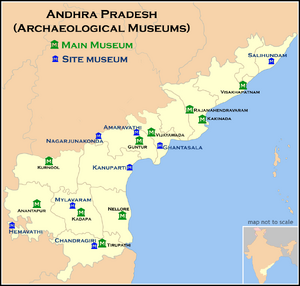Visakhapatnam
| Author:Laxman Burdak, IFS (R) |

Visakhapatnam (विशाखापत्तनम) is a city and district in the Indian state of Andhra Pradesh.
Origin
Variants
- Vijiggapattam विजिगापट्टम = Vishakhapattan विशाखापत्तन (AS, p.853)
- Vishakhapattan विशाखापट्टन = Vijiggapattam विजिगापट्टम , आ.प्र., (AS, p.863)
- Vizag (वाइज़ाग) [1]
- Viśākha विशाख [2]
- Wāltair [3]
History
Visakhapatnam's history stretches back to the 6th century BCE, when it was considered a part of the Kalinga Kingdom, and later ruled by the Vengi, the Pallava and Eastern Ganga dynasties.[4] Archaeological records suggest that the present city was built around the 11th and 12th centuries with control over the city fluctuating between the Chola Dynasty and the Gajapati Kingdom, until its conquest by the Vijayanagara Empire in the 15th century. Conquered by the Mughals in the 16th century, European powers eventually set up trading interests in the city, and by the end of the 18th century it had come under French rule.[5] Control passed to the British Raj in 1804 and it remained under British colonial rule until India's independence in 1947.
One popular belief is that the town was named after Buddhist princess Visakha (5th to 6th Century BC), and is referred to in the Buddhist gathas. Another similar theory attributes the name to a Buddhist monk, Vaisakhi. The Chinese traveller, Hiuen Tsang visited Andhra during 639-40 AD. In his travelogue he mentioned the name of ‘Visakha kingdom’, where Hinayana Buddhism was prevalent. [6]
Another school of thought attributes the name derived from the God of valour, Vishakheshwara. This is supported by the strong belief that there lies submerged a shore temple built by Kuluttonga Chola of the Lord just off the shoreline. Then again, the name is credited to a Muslim saint, Ishaq Madina, revered by all, the Hindus and Muslims, especially those who lived off the sea. And the simplest yet most possible explanation is that the city got its name from its topography; ‘isaka’ is the Telugu word for sand. The vast sand expanses could have contributed to the name.[7]
विशाखापट्टन = विजिगापट्टम
विशाखापट्टन (AS, p.863) पौराणिक किंवदंती के अनुसार यह भगवान शिव के पुत्र कार्तिकेय का नगर है। विशाख कार्तिकेय का ही एक अन्य नाम हैं (दे. अमरकोश 1,40) - 'बाहुलेयस्तार कजिद्विशाखः शिखिवाहनः षाण्मातुर: शक्तिधरः, कुमारः क्रौंचदारणः।' यह नगर अब एक विशाल समुद्रापट्टन है. [8]
विशाखापत्तनम परिचय
विशाखापत्तनम बंगाल की खाड़ी पर चेन्नई (भूतपूर्व मद्रास) के पूर्वोत्तर में लगभग 612 किलोमीटर की दूरी पर स्थित है। यह पूर्वोत्तर आंध्र प्रदेश राज्य का एक महत्त्वपूर्ण शहर है, जो दक्षिण-पूर्वी भारत का हिस्सा है। विशाखापत्तनम एक छोटी खाड़ी पर है और इसका प्राकृतिक बंदरगाह दो उठे हुए अतंरीपों द्वारा निर्मित है, जो शहर से एक छोटी नदी द्वारा विभक्त है। विशाखापत्तनम आंध्र प्रदेश के उत्तरी सरकारी तट पर गोदावरी नदी के मुहाने के उत्तर में अवस्थित है। विशाखापत्तनम को वाइज़ाग के नाम से भी जाना जाता है। विशाखापत्तनम भारत का चौथा सबसे बड़ा बंदरगाह है। यह विशाखापत्तनम ज़िले का मुख्यालय तथा भारतीय नौसेना के पूर्वी कमांड का केन्द्र है।
महत्त्व: विशाखापत्तनम के बंदरगाह का महत्त्व काफ़ी बढ़ा है क्योंकि कोरोमंडल तट पर यही एकमात्र संरक्षित बंदरगाह है। इसमें किए गए सुधारों से अब यह 10.2 मीटर ऊँचे पोतों को भी आश्रय देने की स्थिति में है। यह शहर एक महत्त्वपूर्ण पोत निर्माण केंद्र भी है। भारत में बने पहले स्टीमर का विशाखापत्तनम के बंदरगाह में 1948 में उद्घाटन हुआ था। विशाखापत्तनम मैंगनीज़ व तिलहन का निर्यात करता है और यहाँ एक तेल परिशोधनशाला तथा चिकित्सा संग्रहालय भी है। सघन वनों से युक्त इसके पूर्वी घाट और सुदूर पूर्वी क्षेत्र गोदावरी व इंद्रावती सहित अनेक नदियों द्वारा अपवाहित होते हैं। इस क्षेत्र की अर्थव्यवस्था का आधार कृषि है।
पर्यटन: विशाखापत्तनम प्राचीन बौद्ध विरासत, भूवैज्ञानिक चमत्कार, प्रसिद्ध मंदिरों के एक उदार मिश्रण में संस्कृति, कला और शिल्प आदि के लिए प्रसिद्ध है। यह एक समय के साथ क़दम रखने वाला शहर है, यहाँ तक कि यह शहर अपने समृद्ध अतीत के संरक्षण के प्रति भी सजग है। इसके सुंदर पूर्वी घाट बंगाल की खाड़ी के नीले पानी पर एक जादुई स्पर्श देते हैं।
संदर्भ: भारतकोश-विशाखापत्तनम

